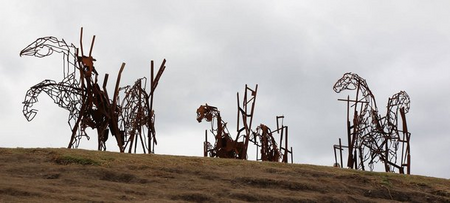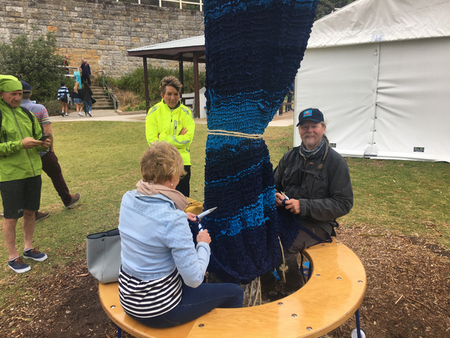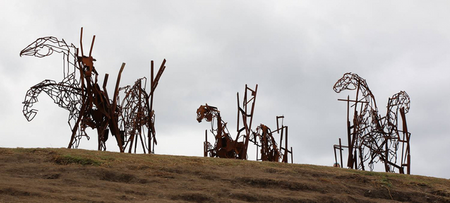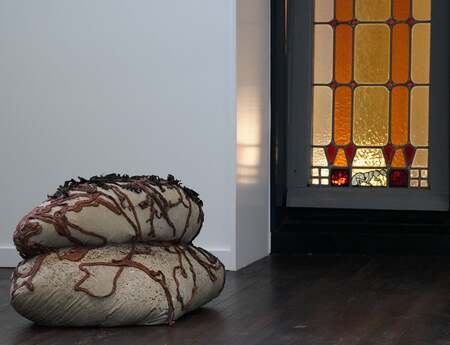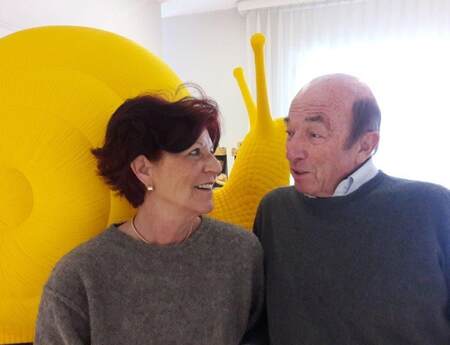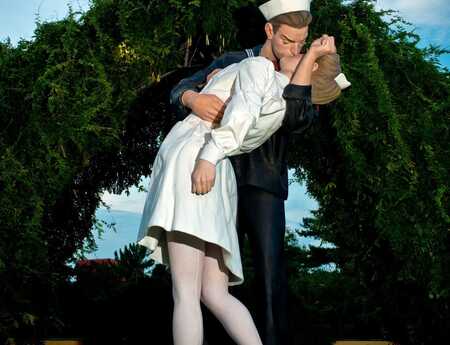Part II – Sculpture by the Sea
Gale force winds are hurling across Tamarana Beach, Sydney. Supposedly spring has sprung, but nobody told him - so I am sitting here duet knitting with rain lashing in my face.
Karl-Christian Geleff is originally from Denmark but lives and works in Sheffield. Like many artists participating in sculpture by the sea he is truly “international”. Artists have always travelled the world to find opportunities to work - so nothing has changed in that respect, despite the debate about globalization - only the distances traveled have increased.
For many artists here this meant moving tons of material from all over the world to these two beaches in Australia. In the end all the artists will have travelled more than 350,000 miles collectively (you can support them through the “Buy a Mile” Campaign) in order to show their work to more than 500,000 spectators.
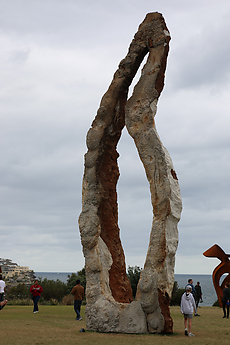
For Karl and his duet knitting performance there is no hustle for material - just a lot of friendly conversations with passers-by. He sits there like a rock in the stormy pre-spring Australian weather.
For sculpture network member Peter Lundberg the financial crisis of 2008 marked a turning point. Decreasing revenue in Europe and a growing demand in Australia made him shift his center of attention. It is a move he has never regretted - quite the contrary to be precise. His artwork stands more than 10 meters high and is the tallest piece in this year’s Bondi exhibition. He spends a few months a year in Australia - his bronze casts are made in China, at a more affordable prize they offer equal level of quality. Several of his works will be part of the newly formed Hillview Sculpture Park (Biennial 2018 coming up).
Harrie Fasher has a particularly moving story to tell - her monumental sculpture “The last Charge” resembles the last successful cavalry charge in the history of warfare. One of her ancestors was involved in the Battle of Beersheba so when she speaks about the occasion you can feel her passion and emotional involvement. The artwork captures the raw emotion of the charge at the Battle of Beersheba on October 31, 1917. This scary vision of cavalry in full flight evokes the roar and chaos of battle and the indefatigable bond between horse and rider. Forged from rusted and twisted steel rods, the horses embody the human, channelling the violence and determination that led to the victory at Beersheba.
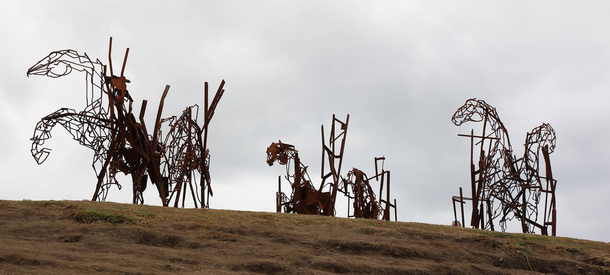
(Harrie Fasher: Tha last Charge. Photocredit: André Kirberg)
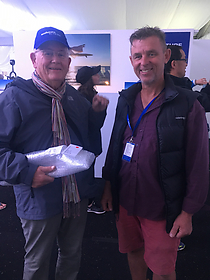
Marcus Tatton came from Tasmania - a little island just outside of Melbourne that is most famous for its devil. His large installation is in the very center of the sculpture by the sea exhibition. His vision is to create engaging sculptures - a mission well accomplished if you consider the number of children climbing around his work outside. Marcus, a former member of sculpture network, tells us about the challenges of his life as an artist in Tasmania - in fact we hear similar stories every once in a while. Transporting the artworks around the country is a major challenge. One artist told us that he has to drive 4,000 km home - it’s the sheer size of Australia that amazes us (we are looking at a 1,000 km drive down to Melbourne ourselves soon). Being a sculptor in Australia is tough business!
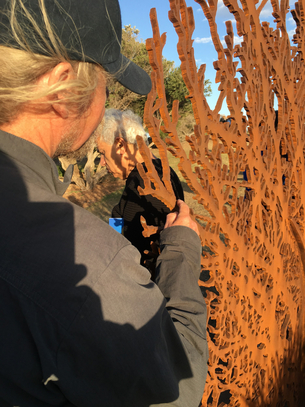
One of the most memorable encounters in Australia was with Zadok Ben-David. We bumped into each other every now and again during our seven days in Sydney. Zadok is a remarkable person full of stories. The most interesting one he told during his keynote speech at the Sydney sculpture conference. It’s about not judging a book by its cover.
In short - he met a steel producer where he wanted to produce his next artworks. Being a bit embarassed by the man persistently wanting to buy a sculpture from him, Zadok offered to give him one of his works for free. He didn’t want the man to know how much his sculptures cost because, with sculpture, people often take the price of the material into account when judging the price of the piece. Finally he was invited to this man’s house and found out that this man has a extensive art collection. Only then does Zadok realize his mistake in judging the man and his knowledge of art simply based on his appearance.
“Never judge a book by it’s cover” is the message he sends to the audience and one other very important sentence:
“You buy the idea of the artist rather than the artwork itself.”
